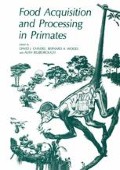Abstract
All attempts to solve the “chin problem”, and understand the reasons why modern humans have a symphysis which differs in shape from that of all other primates, must necessarily incorporate a theoretical understanding of the mechanical principles involved in the lower jaw. Based on a knowledge of the kinetics of mastication provided by Hiiemae (1966, 1967, 1976, 1978), Hiiemae and Crompton (1971), Hiiemae and Kay (1973), Kay and Hiiemae (1974) and on the experimental results obtained and evaluated by Hylander (1975, 1978, 1979a, 1979b, 1979c), I have worked out a mathematical formulation on the principle of stresses involved with the mandible (Wolff, 1982).
Access this chapter
Tax calculation will be finalised at checkout
Purchases are for personal use only
Preview
Unable to display preview. Download preview PDF.
References
DuBrul, E.L. and Sicher, H. (1954) The Adaptive Chin. C.C. Thomas, Springfield (Ill.).
Hiiemae, K.M. (1966) The development, structure and function of the temporomandibular joint in rat. Ph.D. Thesis, University of London.
Hiiemae, K.M. (1967) Masticatory function in the mammals. J. dent. Res. 46: 883–893.
Hiiemae, K.M. (1976) Masticatory movements in primitive mammals. In “Mastication” ( D.J. Anderson and B. Matthews, eds.), pp. 105–118. Wright and Sons, Bristol.
Hiiemae, K.M. (1978) Mammalian mastication: a review of the activity of the jaw muscles and the movements they produce in chewing. In “Development, Function and Evolution of Teeth” ( P.M. Butler and K.A. Joysey, eds.), pp. 359–398. Academic, London.
Hiiemae, K.M. and Crompton, A.W. (1971) A cinefluorographic study of feeding in the American opossum, Dideiphis marsupialis. In “Dental Morphology and Evolution” ( A.A. Dahlberg, ed.), pp. 299–334. Univ. Chicago Press.
Hiiemae, K.M. and Kay, R.F. (1973) Evolutionary trends in the dynamics of primitive mastication. In “Craniofacial Biology of Primates” (M.R. Zingeser, ed.), vol. 3, pp. 28–64. Symp. 4th Internat. Congr. Primat., Karger, Basel.
Hylander, W.L. (1975) The human mandible: Lever or link? Am. J. phys. Anthrop. 43: 227–242.
Hylander, W.L. (1978) Incisal bite force direction in humans and the functional significance of mamalian mandibular translation. Am. J. phys. Anthrop. 48: 1–8.
Hylander, W.L. (1979a) Mandibular function in Galago crassicaudatus and Macaca fascicularis: An in vivo approach to stress analysis of the mandible. J. Morph. 159: 253–296.
Hylander, W.L. (1979b) The functional significance of primate mandibular form. J. Morph. 160: 223–240.
Hylander, W.L. (1979c) An experimental analysis of temporomandi-bular joint reaction force in macaques. Am. J. phys. Anthrop. 51: 433–456.
Kay, R.F. and Hiiemae, K.M. (1974) Jaw movements and tooth use in recent and fossil primates. Am. J. phys. Anthrop. 40: 227–256.
Marx, H. (1966) Die funktionsbedingten elastischen Deformierungen der menschlichen Mandibula. Habil-Schrift, Mainz.
Miller, E. (1966) The chewing apparatus. Acta Physiol. Scand. 69, suppl. 280.
Schumacher, G.H. and Schmidt, H. (1972) Anatomie und Biochemie der Zähne. G. Fischer, Stuttgart.
Sicher, H. (1950) Oral Anatomy. C.V. Mosby and Company, St. Louis.
Wolff, J.E.A. (1982) Die funktionelle Gestalt der menschlichen Unterkiefersymphyse. Minerva-Press, München.
Author information
Authors and Affiliations
Editor information
Editors and Affiliations
Rights and permissions
Copyright information
© 1984 Springer Science+Business Media New York
About this chapter
Cite this chapter
Wolff, J.E.A. (1984). A Theoretical Approach to Solve the Chin Problem. In: Chivers, D.J., Wood, B.A., Bilsborough, A. (eds) Food Acquisition and Processing in Primates. Springer, Boston, MA. https://doi.org/10.1007/978-1-4757-5244-1_17
Download citation
DOI: https://doi.org/10.1007/978-1-4757-5244-1_17
Publisher Name: Springer, Boston, MA
Print ISBN: 978-1-4757-5246-5
Online ISBN: 978-1-4757-5244-1
eBook Packages: Springer Book Archive

